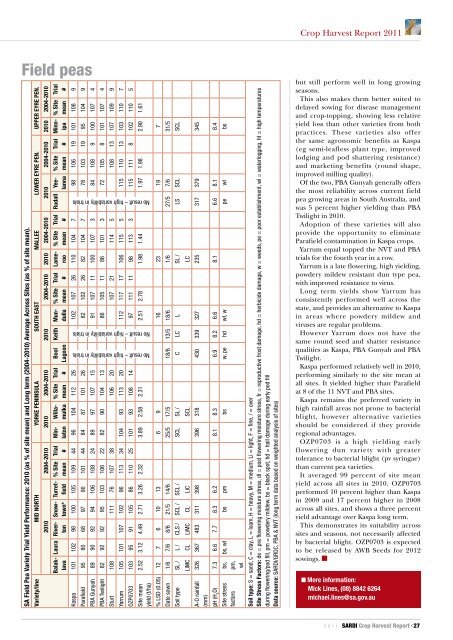Which varieties performed best? - Grains Research & Development ...
Which varieties performed best? - Grains Research & Development ...
Which varieties performed best? - Grains Research & Development ...
You also want an ePaper? Increase the reach of your titles
YUMPU automatically turns print PDFs into web optimized ePapers that Google loves.
Crop Harvest Report 2011Field peasSA Field Pea Variety Trial Yield Performance: 2010 (as % of site mean) and Long term (2004-2010) Average Across Sites (as % of site mean).Variety/line MID NORTH YORKE PENINSULA SOUTH EAST MALLEE LOWER EYRE PEN. UPPER EYRE PEN.2010 2004-2010 2010 2004-2010 2010 2004-2010 2010 2004-2010 2010 2004-2010 2010 2004-2010TrialTrialTrialTrialTrialTrial#% SitemeanMinnipa#% SitemeanRudall Yeelanna#% SitemeanLameroo#% SitemeanKeith MundullaBoolLagoon#% SitemeanWillamulkaMinlaton#% SitemeanTurretfieldSnowtown*Laura RivertonBalaklavaKaspa 101 102 98 100 105 109 44 96 104 112 26 102 107 26 110 104 7 98 106 19 101 108 9Parafield 95 80 68 97 90 101 44 84 87 101 26 82 102 26 82 104 7 78 103 19 95 104 9PBA Gunyah 89 90 92 94 106 108 24 89 97 107 15 91 107 11 100 107 3 84 108 9 100 107 4PBA Twilight 82 92 92 95 103 106 22 82 90 104 13 86 105 11 86 101 3 72 105 8 101 107 4Sturt 108 111 76 107 38 106 20 107 21 114 5 108 13 107 109 9Yarrum 105 101 107 102 96 113 34 104 93 113 20 112 117 17 106 115 5 115 110 13 103 110 7OZP0703 103 95 91 105 86 110 25 101 93 108 14 97 111 11 98 113 3 115 111 8 102 110 5Site mean 2.52 3.12 4.49 2.71 3.26 2.32 3.89 2.58 2.31 2.51 2.78 1.98 1.44 1.97 1.98 2.90 1.61yield (t/ha)% LSD (0.05) 12 7 6 10 13 6 9 16 23 19 7Date sown 1/6 7/6 8/6 21/5 14/6 25/5 17/5 18/6 13/5 18/6 1/6 27/5 7/6 31/5Soil type SL / L / CLS / SCL / SCL /SCL SL /C LC L SL /LS SCL SCLLiMC CL LiMC CL LiCSCLLCA-O rainfall 326 367 483 311 398 396 318 430 339 327 235 317 379 345(mm)pH (H 2O) 7.3 6.6 7.7 8.3 6.2 8.1 8.3 6.9 8.2 6.6 8.1 6.6 8.1 8.4bs, wl bs pm bs w, pe hd wl, w pe wl bsNo result – high variability in trialsNo result – high variability in trialsNo result – high variability in trialsbs,pm,wlSite stressfactorsSoil type: S = sand, C = clay, L = loam, H = heavy, M = medium, Li = light, F = fine, / = overSite Stress Factors: de = pre flowering moisture stress, dl = post flowering moisture stress, fr = reproductive frost damage, hd = herbicide damage, w = weeds, pe = poor establishment, wl = waterlogging, ht = high temperaturesduring flowering/pod fill, pm = powdery mildew, bs = black spot, hd = hail damage during early pod fillData source: SARDI/GRDC, PBA & NVT (long term data based on weighted analysis of sites)but still perform well in long growingseasons.This also makes them better suited todelayed sowing for disease managementand crop-topping, showing less relativeyield loss than other <strong>varieties</strong> from bothpractices. These <strong>varieties</strong> also offerthe same agronomic benefits as Kaspa(eg semi-leafless plant type, improvedlodging and pod shattering resistance)and marketing benefits (round shape,improved milling quality).Of the two, PBA Gunyah generally offersthe most reliability across current fieldpea growing areas in South Australia, andwas 5 percent higher yielding than PBATwilight in 2010.Adoption of these <strong>varieties</strong> will alsoprovide the opportunity to eliminateParafield contamination in Kaspa crops.Yarrum equal topped the NVT and PBAtrials for the fourth year in a row.Yarrum is a late flowering, high yielding,powdery mildew resistant dun type pea,with improved resistance to virus.Long term yields show Yarrum hasconsistently <strong>performed</strong> well across thestate, and provides an alternative to Kaspain areas where powdery mildew andviruses are regular problems.However Yarrum does not have thesame round seed and shatter resistancequalities as Kaspa, PBA Gunyah and PBATwilight.Kaspa <strong>performed</strong> relatively well in 2010,performing similarly to the site mean atall sites. It yielded higher than Parafieldat 8 of the 11 NVT and PBA sites.Kaspa remains the preferred variety inhigh rainfall areas not prone to bacterialblight, however alternative <strong>varieties</strong>should be considered if they provideregional advantages.OZP0703 is a high yielding earlyflowering dun variety with greatertolerance to bacterial blight (pv syringae)than current pea <strong>varieties</strong>.It averaged 99 percent of site meanyield across all sites in 2010. OZP0703<strong>performed</strong> 10 percent higher than Kaspain 2009 and 17 percent higher in 2008across all sites, and shows a three percentyield advantage over Kaspa long term.This demonstrates its suitability acrosssites and seasons, not necessarily affectedby bacterial blight. OZP0703 is expectedto be released by AWB Seeds for 2012sowings.More information:Mick Lines, (08) 8842 6264michael.lines@sa.gov.au2 0 1 1 SARDI Crop Harvest Report < 27

















